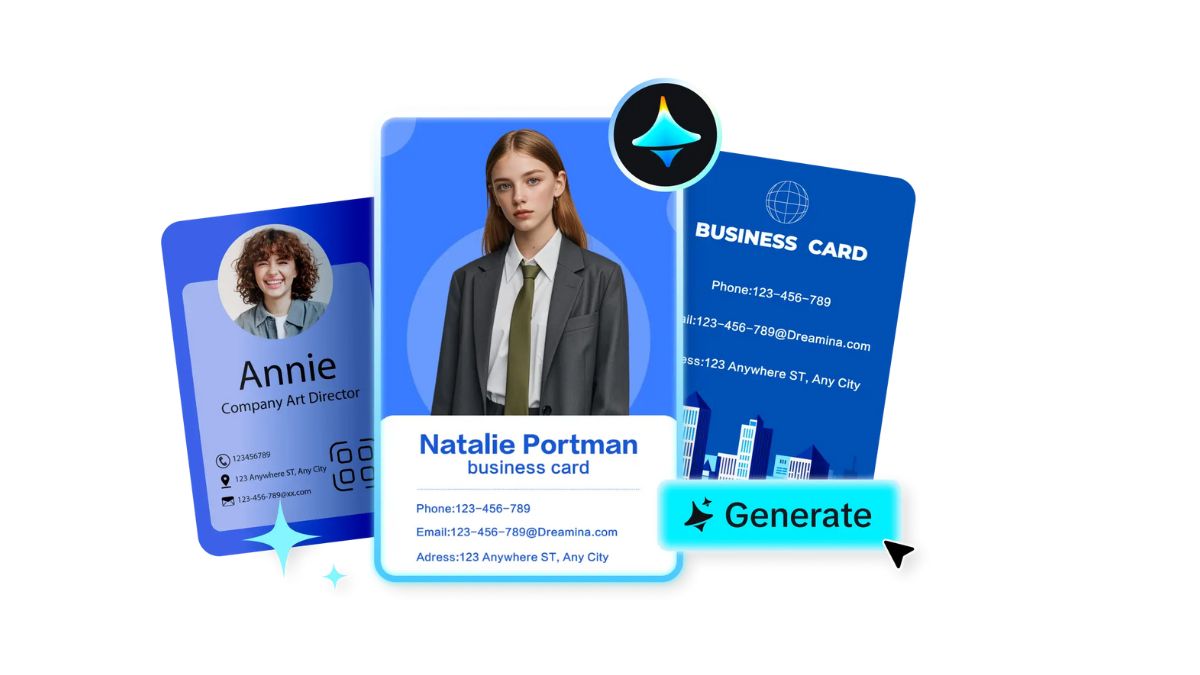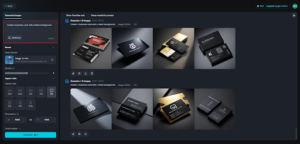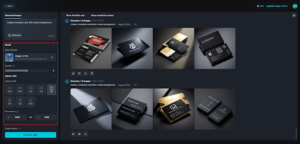DIGITAL MARKETING
6 Common Mistakes to Avoid When Designing Business Cards

Receiving a business card that either impressed you or made you think, “What were they thinking?” is something we’ve all experienced. Designing a business card may seem easy, but it’s simple to make mistakes that can affect how others perceive you and your business. After all, your card is a reflection of your brand, so you want it to leave a good, lasting impression. If you’re new to business card design or simply looking to improve your skills, this blog is for you. To help you avoid common pitfalls, we’ll walk you through six mistakes people often make when creating and printing business cards, and show you how to steer clear of them. With the best AI image generator right at your fingertips, you can easily design a professional-looking business card that stands out!

- Too much text
One mistake many people make when designing business cards is adding too much text. It seems like a good idea to include everything, but it just ends up making the card look messy and hard to read.
Your business card should only include the following basic information:
- Your name
- Job title or position
- Contact details
- Company logo
Anything else can be shared later in an email or conversation. Keeping it simple helps the person reading your card easily understand your details and reach out to you.
- Choosing the wrong font
Fonts play a big role in your business card design, but picking the wrong one can hurt your card’s look. Fancy fonts can make your card seem unprofessional. It’s best to choose a font that’s clean and easy to read.
A few tips for picking fonts:
- Stick to one or two fonts. Using too many can make your card look messy.
- Pick fonts that match your brand’s style.
- Make sure the text is readable and understandable. Business cards are small, so clarity is really important.
If you want to design a card that looks great and is easy to read, tools like Dreamina’s business card generator can help. It lets you try out different fonts and layouts, giving you a professional design in just a few clicks.
- Poor quality images
When designing your business card, it’s important to use high-quality images. Low-resolution or blurry pictures can make your card look unprofessional and unappealing. Make sure any logos, images, or graphics you use are clear and sharp.
Using the right design tool that meets all your requirements can make a huge difference. Look for options that help you create designs with high-quality images and materials that match your brand. This way, you can customize logos, backgrounds, and textures easily to make sure your card looks polished.

- Inconsistent branding
Your business card should match your brand’s identity. Using different colors, fonts, or logos can confuse your clients and make your business seem less trustworthy.
To keep your brand consistent, always use the same color scheme, fonts, and logo placement as your other marketing materials. If you don’t have a design yet, free AI logo generator can help you create a logo that fits your business. It offers different styles, from minimalist to vibrant, so you can find the perfect look for your brand.
By keeping your business card consistent with your branding, you’ll build recognition and show professionalism.
- Ignoring the back of the card
Many people focus only on the front of the business card and forget about the back. But the back of your card is a great space to add extra details, like:
- A short description of your company
- A CTA (call to action)
- Your social media handles
Using the back of your card smartly can help you stand out and give your contacts more ways to connect with you.

- Neglecting to include essential information
Many people forget to include important details like their phone number or email address. While keeping the design simple is important, you also need to make sure the card has all the contact information the recipient needs to reach out to you.
If you’re unsure about what to include, think about your brand’s style and what information your clients would need to contact you easily.
Create stunning business cards with Dreamina
If you’re new to designing business cards, it can be a bit overwhelming. But with tools like Dreamina, creating a professional and stylish card is super easy. The platform gives you plenty of ways to customize everything from fonts and colors to the layout, all powered by smart AI technology.
Moreover, if you need images to make your business card even better, Dreamina creates high-quality visuals that match your needs.
Here are the 3 steps you need to follow to create your business card:
Step 1: Enter your prompt
Start by entering a specific word or photo. For example, you could type: “Create a business card with a black background.” Make sure your description is clear and precise.

Step 2: Customize and generate
Once you’ve entered your prompt, customize the aspect ratio, quality, and size to fit your needs. Then, click “Generate” to create your image.

Step 3: Save and publish
When your design is just right, save it in your preferred format. You can even share it with friends or post it on social media.

Conclusion
Designing a business card is a small task with a big impact. Avoiding common mistakes like overcrowding your card with text, using low-quality images, or neglecting brand consistency will help ensure your card leaves a positive impression. With tools like Dreamina, you can create a professional card quickly and easily. Customize fonts, colors, and layouts, and even add logos or images to reflect your brand’s identity.
DIGITAL MARKETING
Social Media Advertising: What Agencies Do Behind the Scenes

Social media advertising is pivotal to digital marketing, helping businesses precisely reach and influence targeted audiences on massive scales. Behind eye-catching ads and strategic campaigns lies the meticulous effort of social media agencies. These agencies are essential in navigating the connections between brands and consumers in the digital space. Their intricate work ensures that businesses spend their advertising dollars wisely and reach their goals with maximum impact. By peering into these behind-the-scenes activities, we unveil the strategic foundation that agencies provide for thriving social media campaigns.
Introduction
The expansive world of social media advertising offers many opportunities to promote products and services across various platforms. Success in this domain requires more than simple visibility; it hinges on strategic planning, creative execution, and analytical prowess. Social media agencies are the masterminds behind successful campaigns, ensuring each element is crafted and monitored to achieve the desired outcomes. By uncovering the activities behind the scenes, businesses can gain insights into the intricate processes contributing to their advertising success and digital marketing effectiveness.
Audience Research and Analysis
Audience research and analysis form the cornerstone of any effective social media advertising campaign. Agencies undertake comprehensive research to understand and define the target audience accurately. This involves gathering extensive demographic data, psychographic insights, and behavioral tendencies to construct a precise customer profile. Tools such as social listening, data analytics, and platform-specific insights play crucial roles in this process. By leveraging data from platforms like Socialistics, agencies can access advanced resources to drill down into audience specifics and tailor their targeting strategies for maximum impact. The goal is to create personalized campaigns that deeply resonate with the intended demographic, achieving better engagement and conversion metrics.
Creative Development
Creative development is where the advertising vision takes shape, transforming research into compelling visual narratives. Agencies employ a dedicated team of creative professionals who work tirelessly to craft visuals and narratives that captivate and resonate. This involves designing attention-grabbing images, selecting impactful imagery, and developing engaging headlines that hold the audience’s attention. Creative teams collaborate closely with strategists to ensure each advertisement is artistically appealing and strategically focused. The result is cohesive imagery and copy that draws in viewers and aligns seamlessly with the brand’s core message and campaign goals.
Campaign Management
Campaign management is a crucial phase where strategic planning meets execution. Agencies meticulously plan every aspect of the campaign, from setting clear objectives to allocating the budget and selecting the optimal platforms for ad placement. They analyze audience insights to determine peak times for content delivery, maximizing visibility and engagement potential. By continuously monitoring ad expenditures against performance indicators, agencies can ensure campaigns are on track to meet their goals without exceeding budget allocations. The flexibility to adapt strategies in real-time is vital, allowing adjustments based on performance metrics and audience interactions.
Analytics and Reporting
Accessing and analyzing data is integral to gauging the success of social media advertising efforts. Social media agencies utilize sophisticated analytics tools to measure key performance indicators like engagement, click-through, and conversion rates. This data-driven approach provides a detailed assessment of how well a campaign resonates with its audience. Agencies compile extensive reports that provide insights into campaign efficacy, helping to visualize the return on investment and justify advertising expenditures to stakeholders. Such transparent reporting fosters a robust relationship between agencies and clients, enhancing trust and demonstrating the tangible value that social media advertising can deliver.
Continuous Optimization
The dynamic nature of the social media landscape necessitates constant refinement and optimization of campaigns. Continuous optimization involves conducting A/B tests to compare different versions of advertisements, tweaking audience targeting parameters, and iterating on creative executions to enhance performance. Agencies leverage algorithms and advanced data analytics to identify opportunities for improvement, ensuring that campaigns remain practical and relevant over time. This proactive approach allows campaigns to evolve alongside audience preferences and platform shifts, maintaining high engagement rates and maximizing return on investment.
Conclusion
The intricate efforts of social media agencies, often occurring behind the scenes, are vital to the success of any advertising campaign. From in-depth audience research and creative development to meticulous campaign management, analytics, and continuous optimization, agencies provide comprehensive support that enhances a brand’s online presence and engagement. Understanding these complex processes underscores these professionals’ significant contributions to a brand’s digital success. By leveraging the expertise of social media agencies, businesses can forge stronger connections with their audience, achieve their marketing objectives, and secure a competitive edge in the digital marketplace.
DIGITAL MARKETING
The Rise of Digital Sales Solutions: Adapting to New Market Trends

Introduction to Digital Sales Solutions
In the digital age, sales and marketing are moving from conventional approaches to cutting-edge digital solutions. Businesses are integrating digital tools to enhance operational efficiency and customer experience. Companies like LoTech offer insights into optimizing sales processes using cutting-edge digital tools. Saturated marketplaces require accuracy and quickness, so digital transformation in sales is not just a fad but a requirement. Digital solutions enable businesses to reach a wider audience and maintain a competitive edge through enhanced customer interactions and service.
Benefits of Embracing Digital Tools
Digital tools in sales strategies provide numerous benefits, including automating routine tasks. The tools allow sales teams to focus on strategic initiatives like building client relationships and enabling personalized customer interactions. Data analytics and insights allow businesses to customize communications and offer to match certain audiences’ demands, increasing consumer happiness and loyalty. This personalized approach boosts morale and engagement among team members.
Key Market Trends Shaping the Future
The digital sales landscape is undergoing significant changes, focusing on personalized customer experiences and automation. Companies use big data and analytics to understand customer behavior, enabling customized marketing strategies. Automation, such as chatbots handling customer queries and automated sales funnel management, saves time and resources, ensuring a more efficient customer experience. Adopting these trends allows businesses to respond to market shifts and maintain competitiveness.
Tools and Technologies Leading the Way
Digital sales transformation relies on CRM systems like Salesforce, which offer a centralized platform for managing customer data, tracking interactions, and forecasting sales performance. These tools enable sales teams to create more effective strategies and provide personalized customer service, improving company efficiency and performance. Users can explore the benefits of CRM software to understand its impact on business operations.
Best Practices for Implementing Digital Sales Solutions
A well-planned strategy is needed to implement digital sales solutions successfully. This strategy thoroughly assesses current sales processes, defines clear objectives, selects appropriate technologies, and provides ongoing training for teams to use new digital tools effectively. Change management is crucial, with employee buy-in being key for smooth adoption. Including all stakeholders and keeping lines of communication open may promote a culture of innovation and reduce opposition. This approach ensures the successful implementation of digital sales solutions.
Future Prospects of Digital Sales Solutions
As artificial intelligence is incorporated into sales, digital solutions will continue evolving and adapting. It will provide real-time insights and adaptive strategies, enabling businesses to anticipate customer needs and set new customer service and engagement standards. Digital transformation in sales is crucial for business longevity in a rapidly digitalizing world, allowing businesses to refine their sales processes and maintain a competitive edge.
DIGITAL MARKETING
The Importance of Digital Advertising Services

Adapting to a Digital-First Economy
The rapid shift toward a digital-first economy has redefined how businesses engage with their audiences. Traditional advertising channels, such as print, television, and radio, while still relevant, no longer provide the same level of reach, targeting, and measurable performance as digital advertising. With consumers spending more time online, businesses must adopt digital strategies to remain visible, competitive, and capable of driving meaningful customer interactions.
Digital advertising enables companies to connect with their target audience in real-time, track user behavior, and refine campaigns based on data-driven insights. Unlike traditional methods, digital platforms offer immediate feedback on performance, allowing businesses to make strategic adjustments that maximize return on investment. The ability to target specific demographics, personalize marketing messages, and optimize advertising spend makes digital advertising a critical tool for sustainable growth.
Precision Targeting and Audience Engagement
One of the most significant advantages of digital advertising is its ability to reach highly targeted audiences. Platforms such as Google Ads, social media networks, and programmatic advertising allow businesses to define their ideal customer profiles and deliver relevant ads based on search behavior, browsing history, interests, and demographics.
Key benefits of digital targeting include:
- Behavioral Targeting – Serving ads based on users’ past actions, such as website visits or search queries.
- Demographic and Geographic Targeting – Customizing campaigns to specific age groups, locations, and interests.
- Retargeting and Remarketing – Re-engaging potential customers who have interacted with a brand but have not yet converted.
- Lookalike Audiences – Using data from existing customers to find new prospects with similar behaviors and interests.
By delivering personalized advertising experiences, businesses can increase engagement rates, improve conversion potential, and build stronger connections with their target audience.
Data-Driven Decision Making and Optimization
Unlike traditional advertising, where results are often difficult to measure, digital advertising provides businesses with valuable insights into campaign performance. Platforms like Google Analytics, Meta Business Suite, and third-party advertising tools allow marketers to track impressions, clicks, conversions, and customer interactions in real-time.
Key performance indicators (KPIs) that digital advertising can measure include:
- Click-Through Rate (CTR) – The percentage of users who click on an ad after seeing it.
- Cost Per Acquisition (CPA) – The total cost of acquiring a customer through an ad campaign.
- Return on Ad Spend (ROAS) – The revenue generated for every dollar spent on advertising.
- Engagement Metrics – Including time spent on site, bounce rate, and interaction with digital content.
By continuously analyzing these metrics, businesses can refine their digital advertising strategies, allocate budgets effectively, and maximize campaign efficiency to achieve their objectives.
The Role of Digital Advertising Services
Businesses looking to enhance their online presence and advertising performance often turn to professional digital advertising services to manage their campaigns. These services provide expertise in search engine marketing (SEM), social media advertising, display ads, and video marketing, ensuring that businesses achieve their marketing goals efficiently.
Key offerings of digital advertising services include:
- Pay-Per-Click (PPC) Management – Creating and optimizing search engine and social media ad campaigns.
- Social Media Advertising – Running targeted ad campaigns on platforms like Facebook, LinkedIn, and Instagram.
- Programmatic Advertising – Utilizing AI-driven ad placements to optimize bidding and targeting.
- Content Marketing and Native Advertising – Integrating promotional content seamlessly into digital experiences.
- Performance Tracking and Optimization – Monitoring ad effectiveness and adjusting strategies for continuous improvement.
By leveraging digital advertising services, businesses can enhance their online visibility, drive qualified traffic, and convert leads into loyal customers more effectively.
Cost-Effectiveness and Higher ROI
Digital advertising provides businesses with cost-effective marketing solutions that deliver measurable results. Unlike traditional advertising methods, which often require substantial upfront investment, digital advertising allows for flexible budgeting, scalable campaigns, and performance-based spending.
Advantages of digital advertising’s cost-effectiveness include:
- Budget Control – Advertisers can set daily or campaign-based budgets to ensure spending remains within financial constraints.
- Pay-for-Performance Models – Many digital platforms operate on PPC models, meaning businesses only pay when users engage with their ads.
- Real-Time Adjustments – Campaigns can be optimized instantly, reallocating budgets to high-performing ads and pausing underperforming ones.
- Long-Term Impact – Data insights allow businesses to refine future campaigns, reducing wasted ad spend and increasing return on investment.
With digital advertising, businesses can optimize their ad spend and ensure that their marketing dollars are being used efficiently to drive tangible results.
Enhancing Brand Awareness and Online Presence
A strong online presence is essential for businesses looking to build brand awareness and credibility. Digital advertising plays a crucial role in expanding brand reach, positioning companies in front of new audiences, and reinforcing brand messaging across multiple digital touchpoints.
Key brand-building strategies enabled by digital advertising include:
- Search Engine Marketing (SEM) – Ensuring a brand appears at the top of search engine results for relevant queries.
- Social Media Engagement – Promoting brand stories, thought leadership, and customer testimonials through paid social campaigns.
- Video Advertising – Using platforms like YouTube and TikTok to engage audiences through compelling visual content.
- Display and Native Advertising – Placing branded content on relevant websites and digital publications.
By maintaining a consistent digital advertising presence, businesses can establish trust, increase brand recall, and attract new customers in an increasingly competitive market.
Keeping Up with Consumer Behavior and Digital Trends
Consumer behavior is constantly evolving, with digital interactions playing a more significant role in purchase decisions. Businesses that fail to adapt to digital advertising risk losing relevance in an era where consumers expect personalized, seamless, and engaging online experiences.
Trends shaping the future of digital advertising include:
- Artificial Intelligence and Automation – Enhancing ad targeting and content recommendations through AI-powered algorithms.
- Voice Search Optimization – Adapting ad strategies to cater to voice-activated search queries.
- Interactive and Immersive Ads – Leveraging augmented reality (AR) and interactive content to engage users.
- Privacy-First Advertising – Adapting to evolving data privacy regulations and implementing first-party data strategies.
Businesses that stay ahead of digital trends and consumer preferences will be better positioned to maintain customer engagement and drive long-term growth.
The Necessity of Digital Advertising in a Competitive Landscape
Digital advertising is no longer an optional marketing tool—it is a necessity for businesses looking to grow, compete, and succeed in today’s digital-first world. From targeting the right audiences and optimizing ad spend to building brand awareness and adapting to evolving consumer behavior, digital advertising offers unparalleled opportunities for business expansion.
By leveraging digital advertising services and adopting a data-driven approach, businesses can drive consistent engagement, improve conversion rates, and establish a strong online presence that fuels long-term success in an ever-evolving marketplace.
-

 BLOG2 months ago
BLOG2 months agoIZoneMedia360 .Com: Exploring the Features and Benefits
-

 BLOG5 months ago
BLOG5 months agoAbout Blog TurboGeekOrg: A Go-To Hub for Tech Enthusiasts and Latest Innovations
-

 BLOG5 months ago
BLOG5 months agoWhat is a Golden Transit in Magi Astrology?
-

 BLOG2 months ago
BLOG2 months agoA Complete Guide to ProcurementNation.com Shipping
-

 ENTERTAINMENT5 months ago
ENTERTAINMENT5 months agoTyquaez Pickett: A Rising Star in the Entertainment World
-

 NEWS1 month ago
NEWS1 month agoChloe Berger News: Insights on Employee Rights and Talent Retention
-

 BLOG4 months ago
BLOG4 months agoWho Is Hall Sinclair? The True Story of Olivia Colman’s Son
-

 HOME2 months ago
HOME2 months ago5StarsStocks.com Nickel: Invest for a Bright Future
